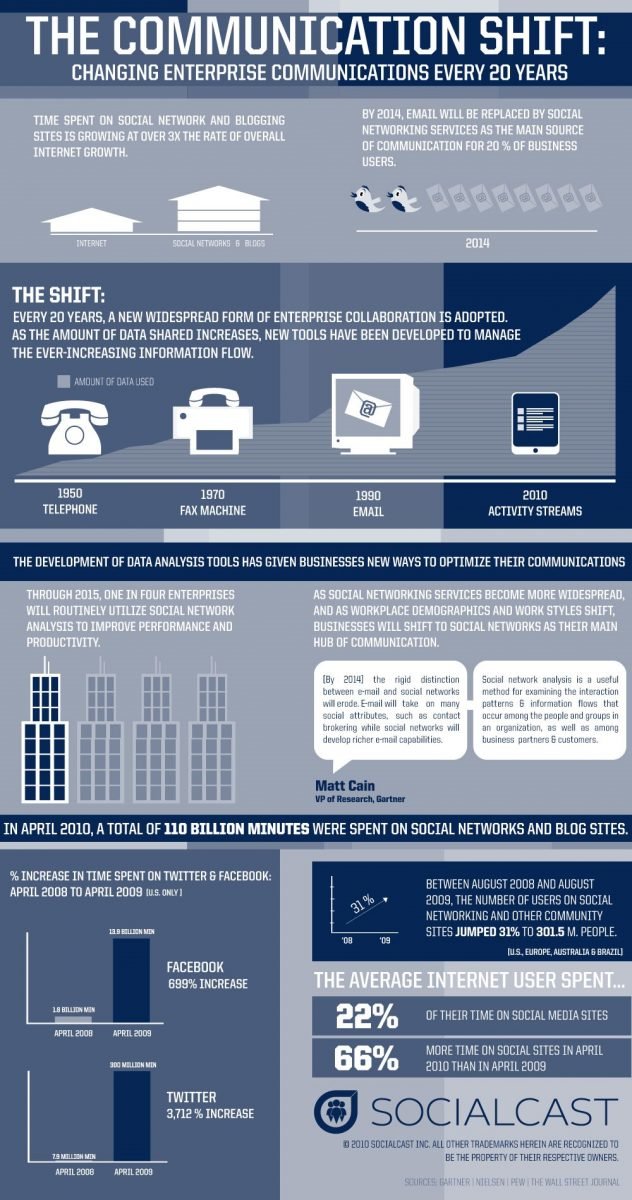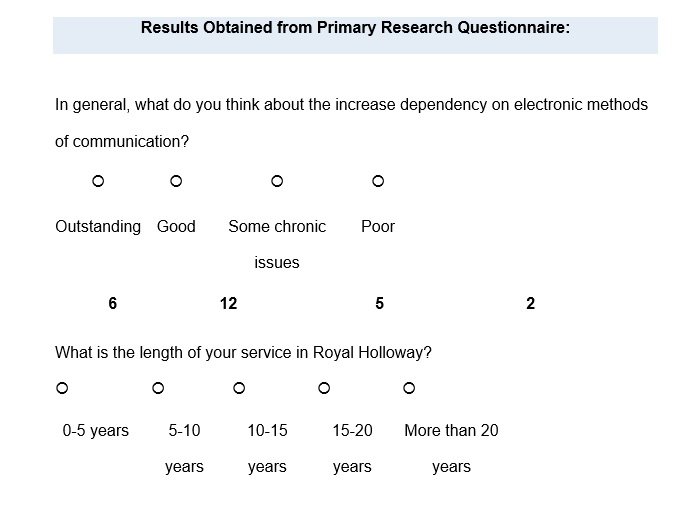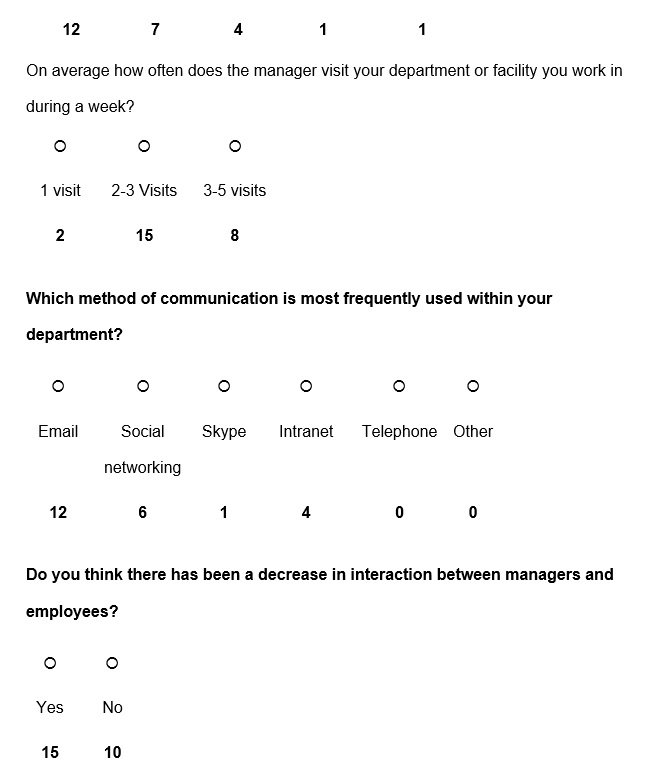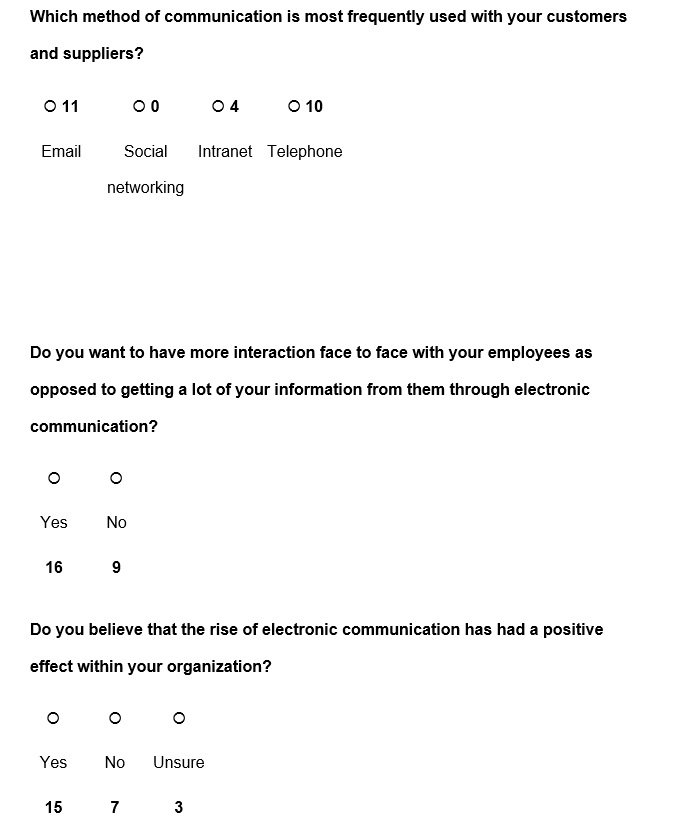Communication in organisations encompasses all the means, both formal and informal, by which information is passed down, up, and across the network. These various modes of communication may be used to disseminate official information between employees and management. It is widely believed that the use of information and communications technology (ICT).
Looking back at the past century, a clear pattern emerges with respect to how companies communicate with their employees. Every 20 years or so, a new form of enterprise collaboration has become widespread. From telephones in businesses (in the 1950s), the fax machine (1970s), and email (1990s), the way businesspeople communicate with each other has drastically altered over the years.
Each technological leap has allowed faster sharing of information and increased the speed at which business can be conducted.
Phelps (2007) asserts that electronic communication facilitates the integration of the various types of media such as graphics, video, audio and text into one message. This implies that electronic communication can be customized in order to meet the needs of a specific type of audience during organizational communication.
This helps in eliminating the barriers to effective communication since electronic communication integrates virtually all the media types. Krizan & Merrier (2007) discusses the responsiveness of electronic communication and concludes that it engages the target audience in a bi-directional communication that is active, which presents an opportunity to transform public relations. Active involvement in the communication increases the response time of the various parties involved during the communication process (Shenja, 2007).
The use of electric communication in organizations helps in improving communications among the members of the organization and mobile personnel by providing real time response and interactive form of communication.
Remote working is increasingly becoming an important element of effective execution of organizational processes are employees are increasingly preferring to work from home and distant locations from the workplace.
In addition, some business processes requires high levels of mobility of the organizational members, who are supposed to maintain constant communication with managers at the head office.
Ferhat & Rachida (2005) states that electronic means of communication comes in handy in addressing this business need by ensuring efficient and timely information delivery on a real time manner.
Rapid transmission is a key characteristic of electronic communication that facilitates rapid information transfer on a large scale. In order for organizations to remain competitive during the information age, business communication must be of comparable speed to the competitors, a challenge that electronic communication addresses.
This implies that electronic communications play a significant role in the expansion of the communication lines within the organization, which in turn increases the capability and the capacity of the organization to act in response to various business situation and demands (Krizan & Merrier, 2007).
Speedy communication of information also plays an integral role in enhancing the significance of information (Phelps, 2007). Haines (2004) argues that the adoption of electronic communication is in concurrence with the strategic goal of information sharing within the business enterprise.
Laudon (2009) asserts that this is significant in increasing the competitive advantage of the business enterprise. Information management and sharing systems are fundamental in the present global markets that are information-based.
Information sharing and workplace collaboration strategies can be deployed by businesses to ease the creation, distribution, representation and the implementation of organizational insights.
Ferhat and Rachida (2005) argue that a business can make use of such a position to increase its organizational efficiency in the present market place. Singh (2010) gives an example of groupware applications that are used for communication and collaboration.
The use of electronic communications also makes significant contributions towards improving organizational efficiency, which is attained by ensuring that there is smooth organizational information and workflow (Krizan & Merrier, 2007).
By exemplifying some of the use of electronic communications between the organizational departments, the performances are appraised to ascertain its usefulness in an organizational context (Laudon, 2009).
The applications and systems are functionally flexible in some circumstances no matter how and where they are used in various business organizations.
The use of these applications and systems improves on speed, reliability, and radical change in general at the operational, tactical, or strategic level in the company or anywhere else in the organizational departments (Phelps, 2007).

Methodology
Primary Research Plan
Questionnaire
The primary purpose of the questionnaire is to capture the key information needed to address the rise of electronic communication (email, social networking, Skype, etc.) and its effects on the ways staff and managers communicate within a business organisation and with their customers and suppliers.
The information obtained will be analysed in order to build up the understanding of the circumstances of these developments. The use of questionnaire is preferred because it facilitates the researchers to acquire enormous amounts of data within a limited time frame (Singh, 2010).
The primary objective of a questionnaire is to encourage and offer motivation to the respondent to actively participate in the interview. This will be achieved through the use of interesting questions and visual aid representations for clarity (Shenja, 2007).
A structured question can be either in form of multiple choices, dichotomous questions or scales. Dichotomous questions are designed to collect the fundamental data from respondents such as the type of business, the communication channels and methods and so on. Dichotomous questions will save time required for the respondents to answer the questions. They will be in a simple format involving Yes or No multiple choice questions.
Face-to-face Interviews
Face to face interviews are vital because the researcher engages in a discussion with the respondent. This ensures that the researcher obtains comprehensive understanding of the information required for the research.
Face to face interviews were conducted through the use of one-on-one meetings with the respondents in order to determine how electronic communication has effected communication between staff and managers and their customers and suppliers. This was used to gather data relating to the type of electronic communication deployed and the various ways that the technology was deployed to facilitate communication.
Company Royal Holloway, University of London
The university is located slightly west of Egham, Surrey, in the United Kingdom. It is a constitutional college of the University of London. An innovative and forward-looking institution, acknowledged worldwide for cutting-edge research and academic excellence.
Data Sources
- Two managers.
- Five staff managers of the various institutional departments at the RUHL.
- Four student records relating to the use of electronic communication in facilitating their learning and communication with their respective tutors.
- International student support in relation to how they make use of electronic communication to facilitate distance learning.
- Bars and restaurants located in the campus in order to determine how they use electronic communication to facilitate business operations and communications with their respective employees and customers.
Communication Methods
The use of electronic communication through avenues such as social networking and Skype does not only enhance the effectiveness of the communication process, but also provides new ways of real time interaction during communication.
The following four methods of communication, including emailing, social networking, video conferencing and intranet will be used in the questionnaire and the face to face interview in order to have a comprehensive understanding of how the various methods of electronic communication were used in the organizations under study.
Electronic mail is a method of communication sending electronic messages via the internet. Email comes as an added advantage that employees can exploit to ensure effective communication and timely response. The advantages of email include:
- Allows users to copy others as correspondents, and also blind-copy (BCC) people.
- Allows sending of attachments such as photographs and spreadsheets.
- Saves time.
- Allows the user to respond at his or her convenience.
- Cost effective.
- Allows employees to respond quickly to customers
- Facilitates effective communication
- Speeds up workflow.
- Saves paper and printing costs.
However, there are also possible downsides of email, including:
- Staff spending too much time on personal emails.
- Spam emails can clutter email inbox.
- Email Hoaxes.
- Viruses can be sent by email.
- Misunderstanding can occur if messages are not constructed properly.
- Confidential information can be easily forwarded and disseminated.
Social networking
Social networking is the grouping of individuals into specific groups that have common interests or share a common social relation. In the business context, social networking provides a means through which people can interact in a real time manner using the internet using applications such as email and instant messaging.
Social networking also helps in the establishment of online communities that are group-centred with the main objective of information sharing, organizing activities and events and regular updates (Laudon, 2009).
Intranet
An intranet is a business’s own private website, it has high confidentiality business network which uses the same underlying structure and network protocols as the internet and is protected from unauthorized users by a firewall (Laudon, 2009).
The RUHL makes use of Moodle and Campus Connect to facilitate student communication with their respective tutors and communication among the student themselves. Intranets are vital in ensuring effective communication within the organization.
Moodle

Moodle is a free e-learning software platform, also known as a course-management System, learning-management system, or virtual learning environment (VLE).
Advantages
- Features which allow large-scale deployment
- Runs without modification on any system.
Campus Connect
Campus Connect is an online server that allows students and instructors to contact each other in a professional manner. It also provides students with information regarding alterations to course structure or coursework. In addition, students are able to make online tuition and fee payments through Campus Connect.
There are several advantages of Campus Connect. However, it also has possible downsides:
- Positives include:
- Easy access.
- cost-effectiveness.
- environmental friendly.
- As for downsides:
- Reduces face-to-face communication between students and instructors.
- Risks of system crashes or information loss.
- Viruses can be easily spread.
Effects of Campus Connect at Royal Holloway
Many companies and organisations view the employees’ time as money. In this regard, Campus Connect has increased not only employee time but also customer (student) time. For example, its email service provided students and staff with a vital portal of communication including an electronic list of all students and staff at RHUL, which makes it quick and easy to get in contact with classmates or staff members.
- Advantages of Campus connect
- Cost cutting by reducing printing.
- Enhances staff efficiency.
- High accessibility since its is online base.
- Reduces administrative work.
- Facilitates easy execution of the organizational processes such as fees payment and teaching.
- Disadvantages of Campus Connect
- Systems crash can result to data loss.
- Reduces one-on-one communication affecting student performance.
- Impairs the development of communication skills.
Videoconferencing
Videoconferencing is the conducting of videoconferences through the use of a set of telecommunication technologies, which include the use of hardware and software applications to facilitate the transmission of both video and audio in a real time manner. This allows two more locations to interact via two-way video and audio transmission simultaneously (Krizan & Merrier, 2007).
A recent research conducted by Wainhouse Research found that smaller companies report meeting online utilizing web conferencing more than any other method, including in-person travel, to drive revenue or conduct business.
Savvy managers will use web and video conferencing to level the playing field and outsmart their competitors. At Royal Holloway, video conferencing is mainly used to facilitate communication between the staff and the students and conduct staff meetings.
- Advantages of video conferencing
- Facilitates immediate response.
- Cost effective through reduction of travel expenses.
- Creates a feeling of involvement because communication requires active involvement of communicating parties.
- Facilitates collaboration because there is sharing of visual displays for every individual who attending the conference.
- Whiteboards enhance collaboration.
- Effective communication that needs remote collaboration such as remote access of documents.
- Disadvantages of Video conferencing
- High costs of equipment acquisition.
- Potential communication barriers such incompatibility in distance communication such as eye contact.
Chart









Discussion
It is arguably evident that the advent of technology and electronic commerce has had an immense impact on our communication methods within our organization along with our customers. The employees interviewed are of the opinion that electronic communication enhances the effectiveness of communication.
From further analysis from the obtained results, it can be identified that the second most frequently used system of communication is social networking, which was mainly conducted via the intranet (Morino Institute, 2011).
This question highlights that RHUL uses a wide range of different communication systems including Email, Intranet and the telephone when staying in contact with customer.
It’s important for RHUL to use a number of different communications including the phone this helps to build a better relationship with their customers as using the phone is more personal and can build trust (Iowa State University, 2011).
The results obtained denote the impacts that electronic communication has on facilitation business communication between the managers and their employees and the customers (Ferhat & Rachida, 2005). The most widely used form of electronic communication is the email, followed by social networking and Skype.
This indicates that organizations are significantly relying on electronic communications, especially the email as an integral element of their strategic communications. Most of the people interviewed were of the opinion that electronic communication served to improve interactions (Ellen & Dana, 2009).
Conclusion
It is arguably evident that electronic communications facilitates the execution of organizational business and communication strategies.
Basing on this perspective, organizations can choose to adopt electronic communication technologies and integrate it into its core business functions as a means of facilitating both internal and external business communication.
Despite the disruptive nature of the electronic communications, that is they are subject to developments every now and then, the underlying fact is that business enterprises have to be abreast with the latest communication platforms in order for the business to operate optimally in the changing business context.
Advancements in information technology have generally transformed the business environment, and normally provide new techniques that can be used for gathering, manipulation, storage and communication of information within the organization.
A lot of business franchises and other organizations have adopted electronic communication as a strategy for reducing the business costs and improving business efficiency.
The businesses that have already implemented electronic communication in their business functions have proven efficient, and there is no reason whatsoever that the firm cannot exploit the opportunity offered by this electronic communication technologies.
Recommendations
In order to enhance the accuracy of this research, it is recommended that the scope of the research to be expanded to include large corporations. This will serve to reveal the true state of affairs relating to how electronic communications enhances the efficiency of communication within the organization.
This should also entail a review of the data collection methods and the selection of organizations in order to increase the accuracy of the results obtained.
With regard to the business recommendations basing on the implications of this research, it is recommended that businesses should rely on electronic communications to facilitate both internal and external communication.
Electronic communication facilitates cost effective and efficient business research processes, which is a core element of the business functions of organizations.
The underlying argument is electronic communications will create newer ways of business research, information processing and facilitate the execution of other business processes at the firm.
This are facilitated by the digital applications that are provided by the electronic communications, and offers more than facilitating communication to include other benefits such as information accessibility through mobility and ease of presentation of such information. Therefore, electronic communications can be argued to improve the ways in which the firm will undertake its business communication.
References
Ellen, G. & Dana, L., 2009. Essentials of Business Communication. New York: Cengage Learning.
Ferhat, K. & Rachida, D., 2005. Testing of communicating systems: 17th IFIP TC6/WG 6.1 International Conference, TestCom 2005, Montreal, Canada: proceedings. New York: Springer.
Haines, D. & Elaine, R., 1999. Illegal immigration in America: a reference handbook. New York: Greenwood Publishing Group.
Iowa State University, 2011. Mass E-mail and Effective Electronic Communication. Web.
Krizan, A.C. & Merrier, P., 2007. Business Communication. New York: Cengage Learning.
Laudon, K., 2009. Essentials of Management Information Systems. New Jersey: Prentice Hall.
Morino Institute, 2011. Why Use Electronic Communications?. Web.
Phelps, B., 2007. Electronic Information systems and organizational boundaries. Technology analysis and strategic management, pp.17-29.
Shenja, Y., 2007. Information communication technologies and emerging business strategies. New York: Idea Group Inc (IGI).
Singh, A., 2010. Business Communication. New York: Anmol Publications PVT.